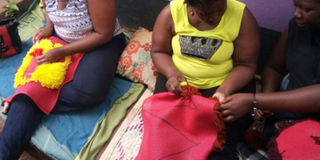Shaggy mats: Easy to make and rewarding

A group of women learn how to make shaggy carpets. Courtesy photo| Remmy Bahati
What you need to know:
- On a conservative side you will need about Shs100,000 but to be exact organise something like Shs200,000 which you will use to buy a number of items including tapestry, a thick textile fabric at about Shs70,000, threads at Shs18,000, a crotchet needle at between Shs3,000 and Shs5,000 and a pair of scissors at Shs5,000.
- Even when you already have a job, it is possible to have some time off to make shaggy carpets. The business can be your main source of income or a side income, writes Dorothy Nakaweesi.
Have you ever thought of using your free time to start a business, for instance making shaggy carpets?
Right, as a stay home mother, student in your vacation or an employee with lots of free time, take up the challenge and try knitting shaggy carpets.
Shag is a rug that is knitted with a deep pile to give it a shaggy appearance. They are a popular household item and one would be excused if they suggested they might replace the actual carpets.
They are easy to clean and add a rare form of beauty and are less cramped up, especially when they are used in a living room, in the bedroom at the foot of your bed or tossed over a chair or couch.
Beyond that, today we shall seek to take you through the possibilities of how you can make shaggy carpets or even earn from them.
Never mind, you do not need much money for this business, as you can start small and grow to handle bulk merchandise.

According to Newton Buteraba, the House of Wealth chief executive officer, a business advisory services company, it is a good start up that anyone can do either as a primary source of income or a side income.
Most of the inputs are imported items but readily available on the local market while others are locally made.
Therefore, you should not be worried of how you will get the material.
On a conservative side you will need about Shs100,000 but to be exact organise something like Shs200,000 which you will use to buy a number of items including tapestry, a thick textile fabric at about Shs70,000, threads at Shs18,000, a crotchet needle at between Shs3,000 and Shs5,000 and a pair of scissors at Shs5,000.
This according to Moreen Suubi, who offers training on how to make shag carpets, is enough for you to start as you look at the bigger picture.
Ideally, she says, you can ably make three carpets in a week on average and more than five for those who have more time on their hands.
“It would be advisable to partner with other people and produce in bulk then supply to perhaps supermarkets or retail shops,” Suubi says.
Ordinarily, she says, it takes about five days for one person to complete a one-meter shag carpet which can be sold at between Shs200,000 and Shs250,000 depending on the design and pattern.
According to Suubi, you will be assured of at least Shs120,000 or Shs150,000 for each shaggy carpet.
This means that if you are able to make four shaggy carpets in a month you will be assured of a monthly income of at least Shs540,000, which translates to an annual income of about Shs6.4m.
Shaggy carpets have a market with the most immediate being around your circle of friends and family.
“Your friends will spread the gospel to others and it’s through this that you will be able to grow your market,” Buteraba says.
Supermarkets and crafts shops are the other market points where you have to display and exhibit your products.
According to Buteraba, you need to make the carpets in bulk as this prepares you for a surge in demand or a sudden pick up.
Social media can be a helpful platform through which you can market the products. Therefore, it would be advisable that you open up pages on platforms such as Facebook, Instagram and Twitter to prop up your business.
Before you start this business, according to Buteraba, you need to acquire some skills in basic knitting and design.
“One good way to acquire these skills is by working with a mentor,” Suubi says, who can help you in the event that you don’t have the money to spend on formal training.
Competition
To beat competition, which among them include imports, according to Buteraba, you need to make quality products that are not only durable but carry a competitive price.
“In order to capture a big market, it is advisable that you make your products affordable. You also need to research on what is on the market and what people like,” he says.
Ideally, he says, imported rugs cost about Shs70,000 and to beat this price, you must be able to provide quality and a competitive price. You must also seek to understand the market through conducting simple surveys. “They might be at the shop next door or in a supermarket faraway,” says Suubi.




